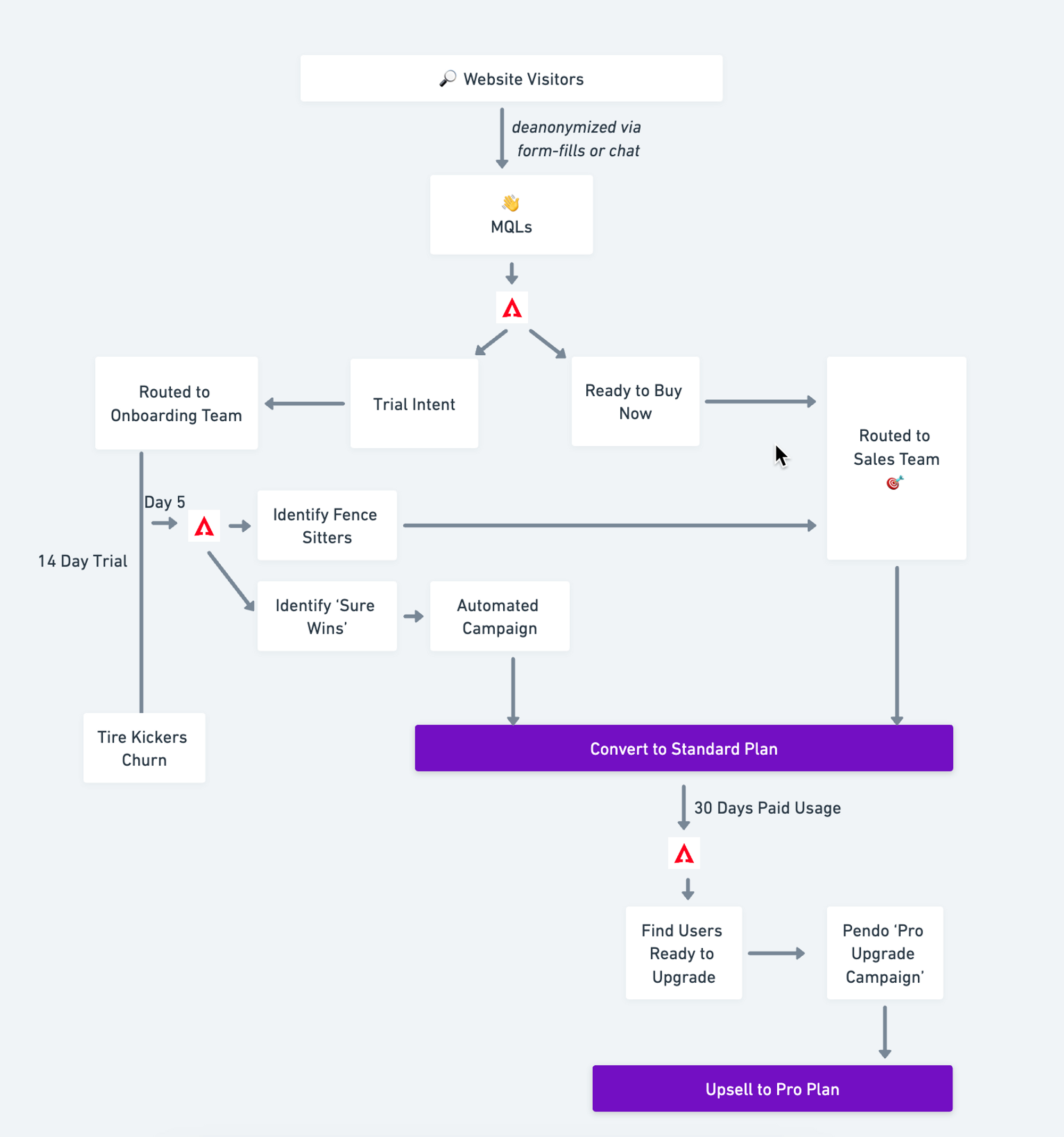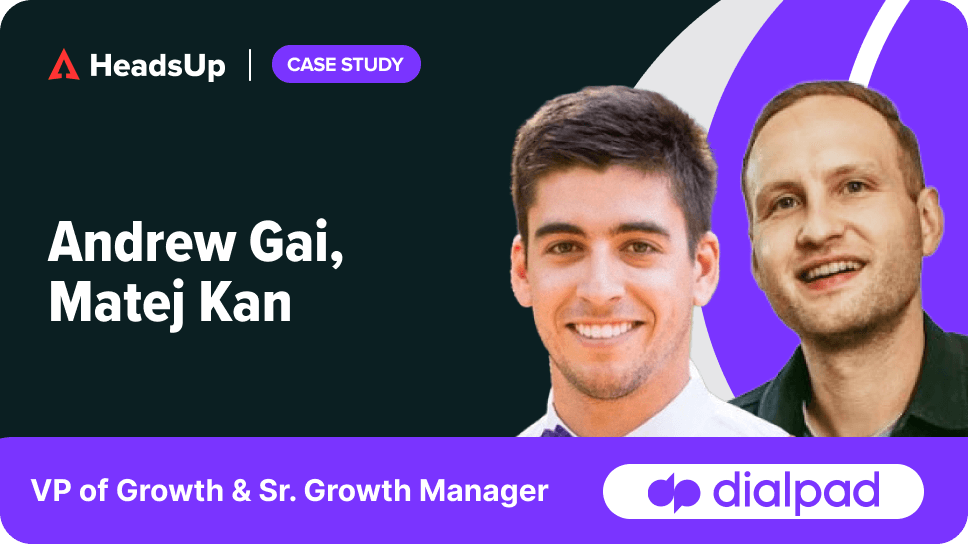Managing a growing TOFU
As Dialpad grew its acquisition programs, the challenge has been to convert thousands of monthly trial signups (and increasing) into revenue. At Dialpad, this task rests upon ~ 12 Product Advocates.
However, even with signups increasing, hiring more Product Advocates to attend to these leads doesn’t guarantee more revenue. Why? Not every one of these trial signups needs a sales touch from a Product Advocate. Some would convert to paid fully self-serve, while others would never convert regardless. Hence, more Product Advocates and the same sales strategy would only mean higher costs and subpar results.
How to increase sales impact without increasing sales headcount?
Andrew’s team knew the more clever lever to pull was to make better use of the existing team by solving their biggest pain. The sales team didn’t have a reliable way of segmenting signups and qualifying these leads, so Product Advocates were wasting sales efforts on signups. If they could just solve this problem, the impact would be significant.
Over the last 6 months, Andrew’s team partnered with HeadsUp to experiment with AI-powered growth programs. The team leveraged HeadsUp’s AI to accurately segment thousands of monthly trial signups according to their propensity to convert to paid. This allowed the Product Advocates to focus their efforts on the ‘fence sitters’, those whose path to conversion would be most impacted by sales intervention. Instead of being spread thin across 100% of the leads, the Product Advocates now focus on only 30% of them but do a much better job on each one.
As a result, Dialpad’s PA team has effectively tripled capacity while maintaining similar or higher conversion rates from lead to revenue.
Familiar intelligent solutions won’t work
Andrew’s team tried the following to drive rep efficiency:
- Empower reps with trial usage metrics — docs visited, button clicks, user demographics — and have them identify which users to touch.
- Use rules or point-based scoring to prioritize leads for engagement — users who placed X calls or sent Y messages in the platform, users who visited XYZ help pages, etc.
- Leverage analytics resources from the Dialpad data and AI teams to help intelligently identify trial signups where a sales touch would make the most impact.
But none of these were good enough for them.
#1 left outcomes solely in the hands of reps. Reps end up spending a lot of their time trying to make educated guesses with the data and less time on high-value customer engagement. Plus, reps are generally not hired for their analytical abilities, so there’s a high degree of variance in outcome here. The team wanted to achieve great outcomes, consistently.
#2 was too blunt to be truly effective. If 2 users were both highly active in the trial, but one was going to convert by themselves versus the other who needed a sales touch, how would the team define an ‘activation’ metric that would distinguish the two? This brought the team back to the problem of reliably segmenting users.
#3 would mean the project would not get done in a reasonable amount of time given that Dialpad’s data and AI teams prioritized building their own AI products and had limited bandwidth to support marketing and sales. This was a priority for Andrew’s team, so they needed a focused team to support their efforts.
Testing HeadsUp
HeadsUp helped Andrew and Mat, Dialpad’s PLG manager, develop an intelligent and actionable program in weeks. Here’s how it’s done:
- HeadsUp pulled historical product usage and conversion data from Dialpad’s data sources like Segment, Salesforce, and BigQuery.
- It then analyzed correlations between product usage patterns and past examples of successful trial-to-paid conversion.
- The HeadsUp algorithm scored new trial signups on Day 5 of their 14-day free trial by their probability to convert to paid.
- Dialpad used these scores to identify a group of users on Day 5 who were ‘fence-sitters’, those who had some potential to convert to paid but needed some help in realizing value over the course of their trial.
- These leads were routed into a multi-touch Outreach sequence that the Product Advocates now exclusively focus on.
Now, Product Advocates are able to limit manual touches to a third of the leads, while maintaining the same free-to-paid conversion rates, even as trial signup volumes increase.
As a result, sales bandwidth has been freed up to focus on other sales motions. Reps no longer waste time contacting signups who will never convert or those who will convert on their own.
How Dialpad is now using HeadsUp AI to drive higher conversion rates, up and down the funnel

Beyond prioritizing trial signup leads for sales touch, Dialpad also employs HeadsUp’s AI capabilities to optimize conversion rates for other revenue motions.
For instance, a separate HeadsUp ML model predicts when Dialpad’s Standard plan users are ready to upgrade to Pro plans. An automated in-app campaign in Pendo leverages this model to target messaging on Pro plan features at just the right time. This results in higher campaign reply and conversion rates and reduces the amount of noise that immature leads receive. Dialpad saw its upsell success rates increase by ~35%.
In another application, Dialpad uses HeadsUp’s AI to score website visitors by their propensity to buy immediately versus converting to a free trial before paying. This scoring allows marketing ops to effectively route leads between a one-touch close sales motion and a trial onboarding flow, optimizing the customer experience and accelerating sales cycles.
Who Mat and Andrew think will need HeadsUp
“If you’re doing anything Product Led Growth, HeadsUp is a no-brainer,” says Andrew.
Optimizing your growth funnel, especially one with high lead volumes and complex datasets, requires significant expertise and analytics capabilities.
Yet most growth teams find themselves either lacking the expertise required to apply data science to their GTM challenges, or the capacity to deploy data science capabilities against a wide range of revenue motions.
HeadsUp exists to do the hard work of translating data into intelligence, so teams like Andrew’s can focus on executing on programs and closing revenue.
If you have large amounts of usage data and need better signal on MQL buying intent and account upsell potential, or are just curious if HeadsUp’s AI can solve a GTM problem you’re facing, get in touch.
